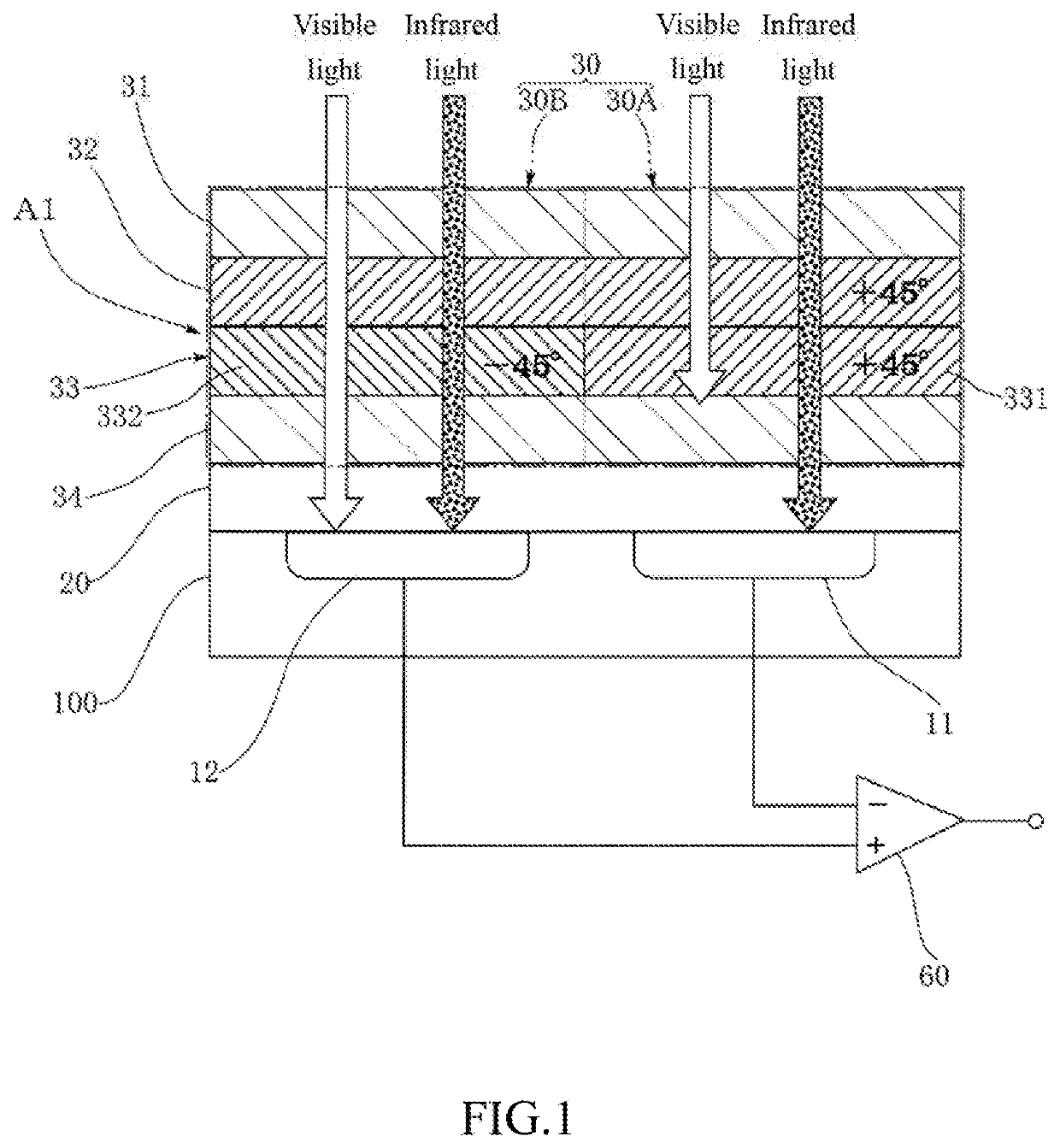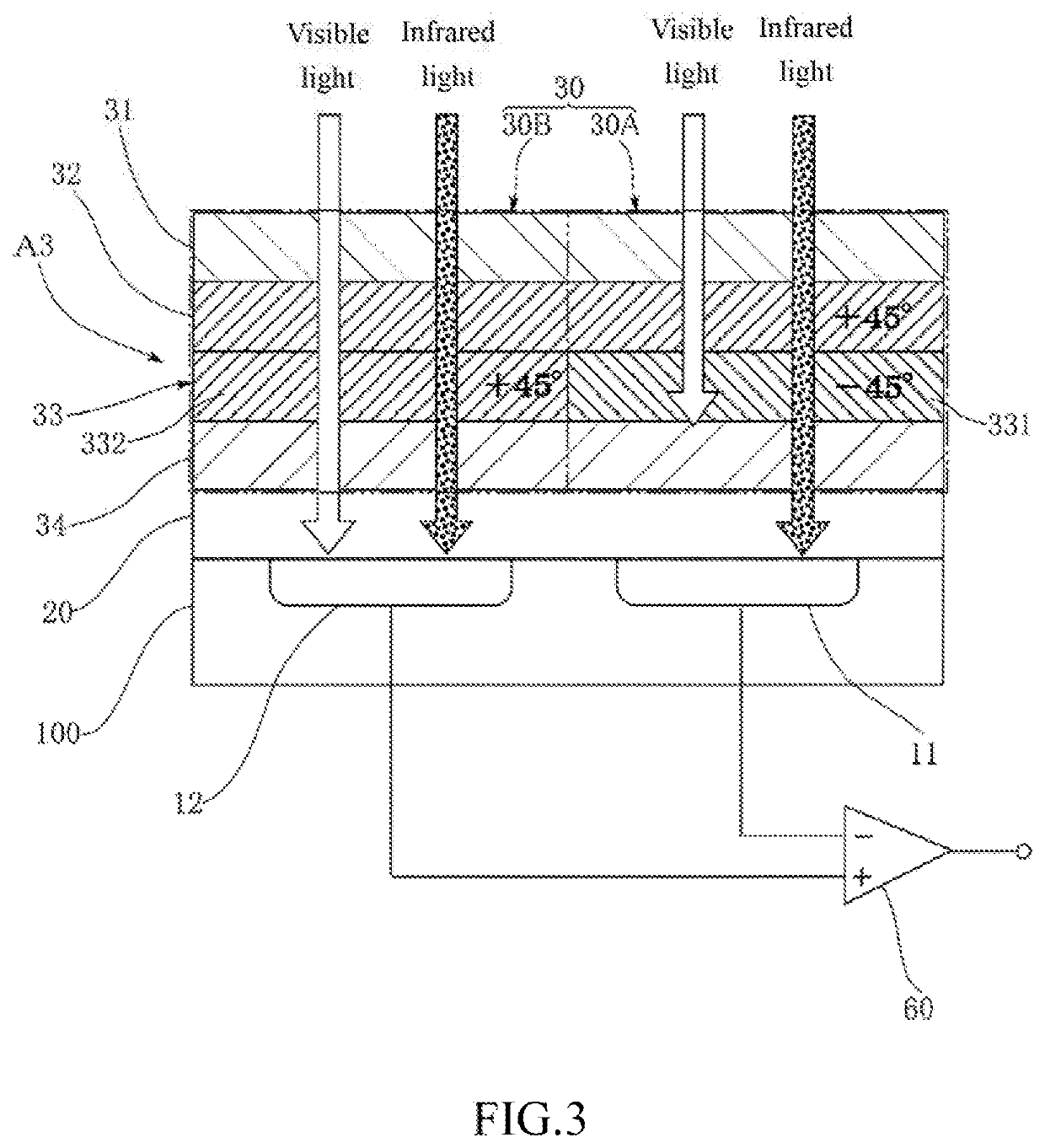Illuminance sensor, electronic machine and 2d image sensor
a technology of illumination sensor and electronic machine, applied in the direction of polarising element, radio frequency control device, instruments, etc., can solve the problems of easy noise caused by illuminance sensor, difficult to dispose of illuminance sensor at a portion separated from the display portion, and narrow width of the so-called border portion around the display portion, etc., to achieve the effect of reducing undesirable influences
- Summary
- Abstract
- Description
- Claims
- Application Information
AI Technical Summary
Benefits of technology
Problems solved by technology
Method used
Image
Examples
first embodiment
[0023]FIG. 1 shows an illuminance sensor according to the present invention, that is, an illuminance sensor A1. The illuminance sensor A1 includes a first light receiving portion 11, a second light receiving portion 12, an optical region 30, and a difference detecting portion 60.
[0024]The first light receiving portion 11 and the second light receiving portion 12 are, for example, photodiodes manufactured and incorporated into the same integrated circuit (IC), and are located in a same plane serving as the main surface of the IC 100. The optical region 30 is disposed opposite to the first light receiving portion 11 and the second light receiving portion 12. The optical region 30 has a first optical region 30A disposed corresponding to the first light receiving portion 11, and a second optical region 30B disposed corresponding to the second light receiving portion 12.
[0025]The optical region 30 (the first optical region 30A and the second optical region 30B) includes a first linear po...
second embodiment
[0065]FIG. 3 shows an illuminance sensor A3 as an illuminance sensor according to the present invention. Compared to the illuminance sensor A1 in FIG. 1, the illuminance sensor A3 differs in terms of the relation of the polarization directions of the first linear polarization plate 31 and the second linear polarization plate 34, and the arrangements and configurations of the first quarter-wave plate 32 and the second quarter-wave plate 33, and the remaining configuration details are identical to those in the illuminance sensor A1 in FIG. 1. That is to say, in the illuminance sensor A3 in FIG. 3, the polarization direction (the first polarization direction) of the first linear polarization plate 31 differs from the polarization direction (the second polarization direction) of the second linear polarization plate 34 by 90°. In FIG. 3, slant shading lines in different directions are used for representation. The first quarter-wave plate 32 is set to “+45°” in the entire of the first opt...
third embodiment
[0101]FIG. 5 shows an illuminance sensor according to the present invention. The illuminance sensor A5 shown in the drawing primary differs from the illuminance sensors A1 to A4 by the configurations of the first light receiving portion 11 and the second light receiving portion 12 and the configuration of the color filter layer 20. Further, in FIG. 5, only the second linear polarization plate 34 in the optical region 30 (the first optical region 30A and the second optical region 30B) is depicted, and the first linear polarization plate 31, the first quarter-wave plate 32 and the second quarter-wave plate 33 are omitted.
[0102]In the illuminance sensor A5 of this embodiment, the first light receiving portion 11 and the second light receiving portion 12 includes a plurality of light receiving elements, respectively. More specifically, the first light receiving portion 11 includes a first light receiving element 111, a second light receiving element 112 and a third light receiving eleme...
PUM
 Login to View More
Login to View More Abstract
Description
Claims
Application Information
 Login to View More
Login to View More - R&D
- Intellectual Property
- Life Sciences
- Materials
- Tech Scout
- Unparalleled Data Quality
- Higher Quality Content
- 60% Fewer Hallucinations
Browse by: Latest US Patents, China's latest patents, Technical Efficacy Thesaurus, Application Domain, Technology Topic, Popular Technical Reports.
© 2025 PatSnap. All rights reserved.Legal|Privacy policy|Modern Slavery Act Transparency Statement|Sitemap|About US| Contact US: help@patsnap.com



